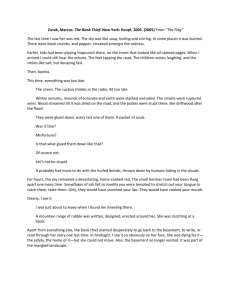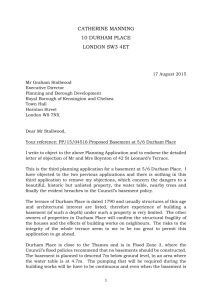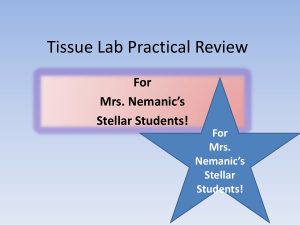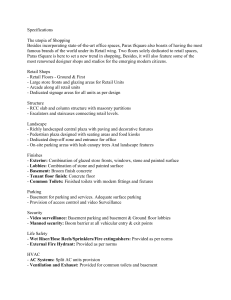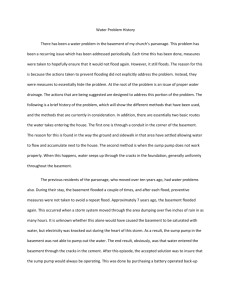Objection Comment-1535709.pdf - Royal Borough of Kensington
advertisement
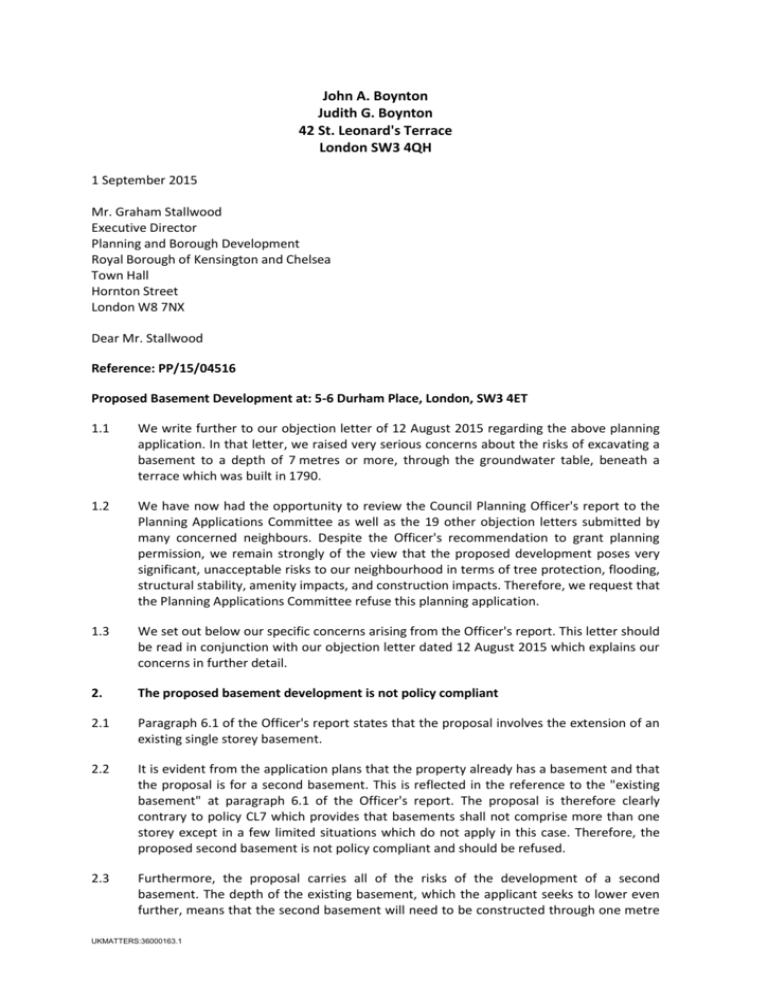
John A. Boynton Judith G. Boynton 42 St. Leonard's Terrace London SW3 4QH 1 September 2015 Mr. Graham Stallwood Executive Director Planning and Borough Development Royal Borough of Kensington and Chelsea Town Hall Hornton Street London W8 7NX Dear Mr. Stallwood Reference: PP/15/04516 Proposed Basement Development at: 5-6 Durham Place, London, SW3 4ET 1.1 We write further to our objection letter of 12 August 2015 regarding the above planning application. In that letter, we raised very serious concerns about the risks of excavating a basement to a depth of 7 metres or more, through the groundwater table, beneath a terrace which was built in 1790. 1.2 We have now had the opportunity to review the Council Planning Officer's report to the Planning Applications Committee as well as the 19 other objection letters submitted by many concerned neighbours. Despite the Officer's recommendation to grant planning permission, we remain strongly of the view that the proposed development poses very significant, unacceptable risks to our neighbourhood in terms of tree protection, flooding, structural stability, amenity impacts, and construction impacts. Therefore, we request that the Planning Applications Committee refuse this planning application. 1.3 We set out below our specific concerns arising from the Officer's report. This letter should be read in conjunction with our objection letter dated 12 August 2015 which explains our concerns in further detail. 2. The proposed basement development is not policy compliant 2.1 Paragraph 6.1 of the Officer's report states that the proposal involves the extension of an existing single storey basement. 2.2 It is evident from the application plans that the property already has a basement and that the proposal is for a second basement. This is reflected in the reference to the "existing basement" at paragraph 6.1 of the Officer's report. The proposal is therefore clearly contrary to policy CL7 which provides that basements shall not comprise more than one storey except in a few limited situations which do not apply in this case. Therefore, the proposed second basement is not policy compliant and should be refused. 2.3 Furthermore, the proposal carries all of the risks of the development of a second basement. The depth of the existing basement, which the applicant seeks to lower even further, means that the second basement will need to be constructed through one metre UKMATTERS:36000163.1 of ground water at 7 metres or more below ground level. This greatly increases the complexity and risk associated with the project and is clearly inconsistent with the intent of the one-storey basement policy. 3. The proposed basement development will result in harm to trees 3.1 Paragraph 6.1 of the Officer’s report concludes from the application documents that “no trees will be harmed” as a result of the development. 3.2 It is incorrect to conclude that there will be no harm to trees. A 22 metre high mature healthy sycamore tree in the property’s rear garden is directly threatened by this basement excavation proposal. This tree is protected by virtue of its location in a Conservation Area. Calculations provided in the applicant’s tree survey indicate that the basement excavation would impact 13% of the sycamore tree’s root protection area, which itself is of great concern. However, Dr. Jon Heuch, an experienced Arboricultural Specialist whom we engaged, assessed the tree risks associated with the planning application to be much greater. In particular, Dr. Heuch advised that: (a) The natural root growing area of the tree is within the garden boundary walls of the property, including where the basement excavation will occur. (b) The basement excavation will require piling to 7 metres below ground level in the rear garden which will sever all of the tree roots in that area. (c) As a consequence the development will reduce the rooting area for the tree within the property’s rear garden from 134 square metres by 36 square metres, a reduction of 27%. 3.3 Dr. Heuch concluded that the impact of the basement excavation on the sycamore tree is likely to be more significant than assessed and is likely to harm the tree. The condition recommended in the Planning Officer’s report will not prevent this harm as the tree’s roots will be severed during excavation. 3.4 The applicant has undertaken no testing within the basement footprint in the rear garden to establish the extent of the sycamore tree roots that will be severed. In accordance with the policy, the Council is entitled to request this information and, in our view, it would be taking an unnecessary and inappropriate risk to grant planning permission for the proposal without full information about the risks to the health and stability of trees. Such a decision would also be contrary to the Council's planning policies which state that basement developments shall not cause loss, damage or long term threat to trees of townscape or amenity value. 3.5 We also are very concerned that the harm to the sycamore tree will cause the tree’s health to decline and its natural life to be shortened. A damaged tree poses safety risks to the neighbours and our properties. This risk is increased as we regularly get very high winds in this area. A weakened or destabilised tree could fall onto neighbours or our properties at any time. Without definitive knowledge that the tree roots will not be harmed, the planning application should be refused. 4. Critical information about the structural and flooding risks is missing 4.1 Paragraph 6.2 of the Officer's report concludes from the application documents that the proposed works would not affect the integrity or stability of the host or surrounding 2 UKMATTERS:36000163.1 properties. There is no information in the report as to how this conclusion was reached and no information addressing the flood risks to surrounding properties. Instead, the Officer's recommendation to grant planning permission appears to rely on the future supervision of the construction works by a chartered engineer. 4.2 As explained in our letter of 12 August, excavating to 7 metres or more below ground level, through the water table, beneath a 225 year old terrace is an inherently high risk proposal. The applicant's own Ground Investigation Report identifies a number of risks and areas where further information is required. This proposal involves significant water management challenges, and poses risks to surrounding buildings and their foundations. 4.3 While the 1-7 Durham Place terrace is not listed, it is of exceptional historical significance given its 225 year age dating back to the 18th century. It is our understanding that certain current and former owners of properties within the 1-7 Durham Place terrace have encountered structural issues associated with non-basement renovation projects. No basement proposal excavated through over one metre of ground water and reaching a depth of 7 metres below ground level within this historic terrace has ever been approved by the Council. 4.4 Based on information in the application documents and the Officer's report, it is not possible to make an informed decision about whether the proposed excavation can be undertaken without posing an unacceptable risk to the structure and fabric of the historic terrace or the stability of surrounding properties. Accordingly, we would urge the Council to seek further information, such as detailed method statements and construction plans, and to take its own engineering advice. Without definitive information that the terrace will not incur structural harm from the proposed basement excavation, this planning application should be refused. 5. There is a lack of transparency about the depth of the basement 5.1 Paragraph 7 of the Officer's report states that the main part of the basement is 3.15m deep with a further 1.85m of depth for the swimming pool. 5.2 It is unclear how this depth has been calculated as the application drawings do not show measurements (or in the case of the proposed elevations the additional depth for the swimming pool) and the application documents variously refer to the basement as being approximately 6 or 7 metres below ground level. Other objectors and their advisors have calculated the basement to be up to 8.35 metres below ground level. 5.3 These differences may depend on whether the internal or external depth is measured and whether the additional excavation to lower the existing basement is included. The Council is entitled to request greater certainty, including accurate planning drawings. Regardless of which measurements are taken, it is clear that the basement will need to be constructed below the groundwater table which will greatly exacerbate the stability and flooding risks noted above. 6. The amenity impacts have been incorrectly assessed 6.1 Paragraph 6.5 of the Officer's report states that the proposed glass doors will not be visible outside the site. 6.2 This conclusion is incorrect, which has led to the impacts on the character and appearance of the Conservation Area being significantly underestimated. The new wall to wall glass 3 UKMATTERS:36000163.1 doors will, in fact, be directly visible from the living areas on the upper floors of some residential properties on Tedworth Square and St. Leonard’s Terrace. In addition, the extent of the proposed glazing will increase light and noise pollution and impact on the sense of privacy for us and many other properties that overlook the garden of 5-6 Durham Place. It is also insensitive to the historical terrace which was built in 1790 and fails to preserve or enhance the character or appearance of the Conservation Area. 7. Conclusion 7.1 As we explained in our letter of 12 August, we consider that the risks of excavating to 7 metres or more below ground level on a constrained site, beneath a historic terrace, and adjacent to several large and beautiful trees, far outweigh the private benefits of the proposal. 7.2 Our concerns have not been adequately considered and addressed in the Officer's report for all of the reasons set out above. Accordingly, we strongly object to the planning application and continue to request that planning permission be refused. We intend to make representations before the Planning Applications Committee on 8 September and would welcome the opportunity to answer any questions that the Committee may have about the concerns set out in this letter. Sincerely, John A. Boynton Judith G. Boynton 4 UKMATTERS:36000163.1
